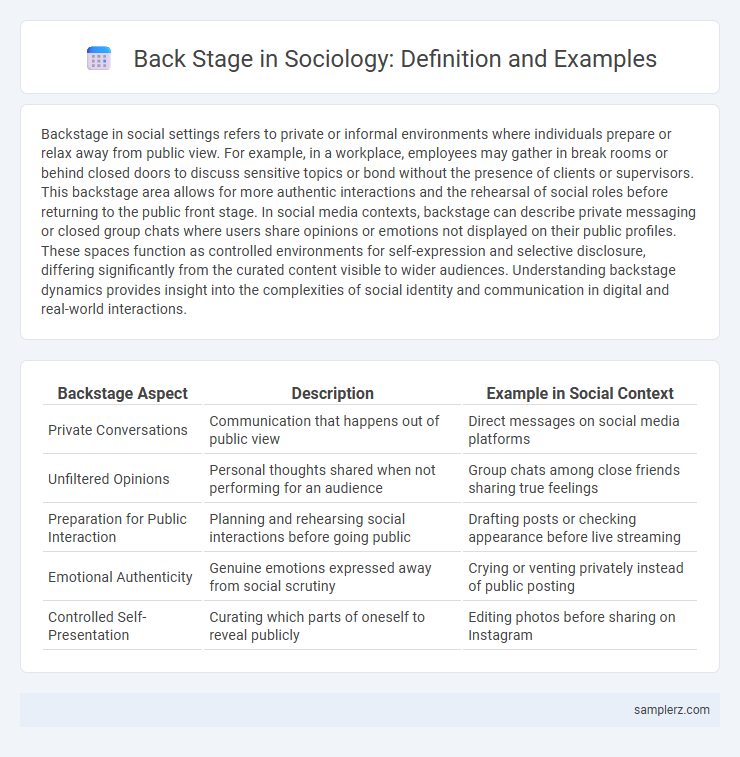Backstage in social settings refers to private or informal environments where individuals prepare or relax away from public view. For example, in a workplace, employees may gather in break rooms or behind closed doors to discuss sensitive topics or bond without the presence of clients or supervisors. This backstage area allows for more authentic interactions and the rehearsal of social roles before returning to the public front stage. In social media contexts, backstage can describe private messaging or closed group chats where users share opinions or emotions not displayed on their public profiles. These spaces function as controlled environments for self-expression and selective disclosure, differing significantly from the curated content visible to wider audiences. Understanding backstage dynamics provides insight into the complexities of social identity and communication in digital and real-world interactions.
Table of Comparison
| Backstage Aspect | Description | Example in Social Context |
|---|---|---|
| Private Conversations | Communication that happens out of public view | Direct messages on social media platforms |
| Unfiltered Opinions | Personal thoughts shared when not performing for an audience | Group chats among close friends sharing true feelings |
| Preparation for Public Interaction | Planning and rehearsing social interactions before going public | Drafting posts or checking appearance before live streaming |
| Emotional Authenticity | Genuine emotions expressed away from social scrutiny | Crying or venting privately instead of public posting |
| Controlled Self-Presentation | Curating which parts of oneself to reveal publicly | Editing photos before sharing on Instagram |
Behind the Scenes: Understanding Back Stage Behavior in Social Settings
Back stage behavior in social settings reveals individuals' true personalities and unfiltered emotions away from public scrutiny, such as candid moments during private gatherings or informal conversations among close friends. These scenarios highlight authentic interactions that contrast sharply with the polished performances people display front stage in formal environments. Understanding back stage behavior provides insight into social dynamics, emphasizing trust, vulnerability, and genuine self-expression.
Private Spaces: Common Examples of Social Back Stage
Private spaces like bedrooms, personal offices, and home bathrooms serve as common examples of social back stage where individuals freely express thoughts and emotions away from public scrutiny. Social media direct messages and private group chats function similarly, providing controlled environments for candid conversations and interactions without the pressure of public performance. These settings enable genuine self-presentation, contrasting with front stage behaviors often curated for social approval.
Unfiltered Moments: What Happens Off the Social Stage
Backstage in social settings reveals unfiltered moments where genuine emotions and spontaneous interactions occur away from the public eye, such as candid conversations at family gatherings or private group chats. These authentic exchanges foster deeper connections by showcasing vulnerability and unscripted behaviors often hidden during formal social events. Understanding backstage dynamics helps highlight the contrast between public personas and true social relationships.
Social Media vs. Reality: Back Stage Examples in Daily Life
Behind carefully curated social media profiles, individuals often experience a stark contrast between their online personas and real-life behavior, revealing the "back stage" of daily existence. Private moments of vulnerability, stress, or ordinary routines are usually hidden from public view, exposing the gap between social media's idealized representations and authentic everyday realities. This discrepancy highlights how platforms like Instagram and Facebook serve as stages for performance rather than true reflections of personal experiences.
Family Gatherings: Revealing True Selves Back Stage
Family gatherings serve as a prime example of back stage social behavior where individuals feel free to express their true selves away from public scrutiny. In this private setting, people often drop formal roles and social masks, allowing authentic emotions, opinions, and interactions to emerge naturally. This contrast between front stage politeness and back stage honesty highlights the complexity of social identity within intimate family dynamics.
Work Environments: Hidden Dynamics Behind Professional Masks
In professional work environments, the backstage reveals hidden dynamics such as unspoken tensions, informal power struggles, and personal frustrations that employees conceal behind their professional masks. These backstage interactions influence decision-making, collaboration, and workplace culture, often shaping outcomes more than formal meetings or official communications. Understanding these covert behaviors is crucial for managers aiming to foster transparency and improve team cohesion.
Friendship Circles: Vulnerability and Back Stage Interactions
Friendship circles provide a critical back stage environment where individuals express vulnerability and share authentic emotions away from public scrutiny. This private setting fosters deeper trust and emotional connection, enabling friends to reveal insecurities and personal struggles without fear of judgment. Such back stage interactions strengthen social bonds by allowing genuine self-expression beyond the polished front stage personas.
Intimate Relationships: Sharing Back Stage Selves
In intimate relationships, backstage behavior reveals authentic emotions and vulnerabilities often concealed in public settings. Partners share unfiltered thoughts, private jokes, and genuine reactions that strengthen emotional bonds and build trust. This backstage sharing fosters deeper connection and intimacy by allowing individuals to present their true selves away from societal expectations.
Cultural Differences in Back Stage Social Behavior
Back stage social behavior varies significantly across cultures, reflecting unique norms and values in private or informal settings. For example, in Japanese culture, back stage interactions often emphasize harmony and indirect communication, whereas in American culture, there may be more open and direct expressions of opinion. Understanding these cultural differences is essential for effective cross-cultural communication and social integration.
The Impact of Back Stage on Social Identity and Authenticity
Back stage behavior reveals individuals' true selves, shaping social identity and fostering authenticity by allowing expressions free from public judgment. This hidden realm contrasts with front stage performances, where social roles are performed to meet societal expectations. The alignment or disparity between these stages significantly influences how people perceive their own identity and the authenticity they project in social interactions.

example of back stage in social Infographic
 samplerz.com
samplerz.com